
Loney's Show Notes
By Glenn Loney, June 2007
About Glenn Loney
 |
| Caricature of Glenn Loney by Sam Norkin. |
Please click on " * " to skip
to each subject in this index:
A TALE OF TWO SHAKESPEARE CITIES: *
In Ashland: The Oregon Shakespearean Festival— *
Southern Oregon Reader-Advisory: *
In America’s First Elizabethan Theatre: *
The Taming of the Shrew [****] *
The Tempest [****] *
Romeo & Juliet [****] *
In the Angus Bowmer Theatre: *
As You Like It [*****] *
Tom Stoppard’s On the Razzle [*****] *
In the New Theatre: *
Tracy’s Tiger [***] *
In Cedar City: The Utah Shakespearean Festival— *
In the Adams Memorial Shakespearean [Globe] Theatre: *
Twelfth Night [****] *
Coriolanus [***] *
King Lear [*****] *
In the Randall L. Jones Theatre: *
Thornton Wilder’s The Matchmaker [Preview] *
Bernard Shaw’s Candida [Preview] *
Lend Me a Tenor: The Musical [Preview] *
Some Summer Shakespeare Festivals: *
A TALE OF TWO SHAKESPEARE CITIES:
The Oregon Shakespearean Festival—in semi-Victorian Ashland, in the heart of the Rogue River Valley with the Panorama of the Siskyou Mountains—is arguably the Oldest Shakespeare Fest in the United States, dating from 1935.
San Diego’s Old Globe has contested this, as its original "replica" of Shakespeare’s Globe was created for Chicago’s Century of Progress Exhibition, in 1933. It then traveled to Texas for the 1936 Centennial—where a young actor named Sam Wanamaker was in the ensemble & got the idea for recreating Shakespeare’s Globe near its original site, on the South Bank of the River Thames in London.
Finally, this now-historic American Old Globe—inaugurated by Thomas Wood Stevens for the Windy City Fair—landed in San Diego for yet another Fair! It has since been rebuilt in more enduring materials & its production-program—like Ashland’s—has steadily expanded. This year’s Tony-winner for stage-direction, Jack O’Brien, has long been based in San Diego at the Globe!
This summer, however, Your Scribe followed his Annual Visit to Ashland with a trip to Cedar City, Utah, home of the Utah Shakespearean Festival. I had not been here since I reported on all US & Canadian Shakespearean Festivals many years ago for Theatre Crafts.
There was so much to share about the many Bardic Fests that the magazine-report expanded into a book: The Shakespeare Complex, published by Drama Books. It will soon be Online in the Glenn Loney Book Shop, located at ArtsArchive.biz…
When I arrived in Cedar City all those years ago—landing in a cow-pasture on a flight from Las Vegas, where I once taught at Nevada Southern University—I found the beginnings of yet another Globe Theatre, designed by my colleague & friend, the late Gene Chesley. [Incidentally, all three of Ashland’s theatres were designed by another colleague & friend, Richard L. Hay—who was a classmate in Stanford University’s Drama Department!]
What both surprised & pleased Founding-Director Fred Adams & his staff was the fact that I had come to this tiny Latter Day Saints community to see the plays, rather than the nearby Natural Wonders. I had no idea I was so close to Bryce & Zion National Parks!
In those days, Tourists stopped over in Cedar City as a base for exploring the remarkable Many-Colored Canyons & Rock-Formations. So they were delighted to discover they didn’t have to watch TV in their motel-rooms in the evenings: Shakespeare was On Tap!
Now they come in droves, specifically to the Utah Shakespearean Festival, with the National Parks as a Daytime Bonus!
In Ashland: The Oregon Shakespearean Festival—For the Record for Those Unfamiliar with Ashland & Its Annual Fest:
Last season—2006—the OSF offered no less than 774 thoroughly Professional Performances of plays by Shakespeare & other Lesser Talents. This was an eight-month season, featuring 11 plays.
No less than 387,474 people saw these productions. In addition to their paying for tickets, lodging, food, souvenirs, & sundries—as well as the money generated by producing the plays & maintaining the ensemble & staff—the Total Economic Impact of the OSF on the Rogue River Region has been calculated at $137,155,439!
Thus, no-one disputes the Production-Budget for 2007: $23,500,000!
In forthcoming seasons, the Oregon Shakespearean Festival will be led by Bill Rauch—who has already won his spurs here with admired stagings. He succeeds the retiring Libby Appel as Artistic-Director.
Rauch’s Inaugural Season—beginning February 2008—will include for the first time a Classic from the Asian Sub-Continent, King Shudraka’s The Clay Cart & a World-Premiere, bound for the Kennedy Center: Julie Marie Myatt’s Welcome Home, Jenny Sutter.
For the first time ever, Ashland’s open-air Elizabethan Stage will welcome a modern non-Elizabethan/Jacobean drama: Thornton Wilder’s Our Town.
Curiously—although Shakespeare’s own open-air Globe Theatre played under Natural Light in the afternoons—no one has thought to provide more Performance-Possibilities in Ashland in summer by offering Matinées on the great open-stage.
[When the indoor Bowmer Theatre & the small Black Swan proved insufficient to meet Playgoer-Demand, the state-of-the-art indoor New Theatre was constructed.]
Actually, when founder Angus Bowmer began with his "First Annual" Shakespearean Festival—even then he was sure there would be a Second Season!—Romeo & Juliet was performed under the scorching afternoon-sun!
This could still be a summer Expansion-Option, for Angus’ fairly basic-stage has—over the years—been successively transformed into one of America’s most sophisticated & Performance-Friendly Arenas.
Next season in the Bowmer, Rauch has programmed two Modern American Classics: August Wilson’s Fences & Arthur Miller’s A View from the Bridge, staged by his predecessor, Libby Appel.
Also on view in this venue will be the Bard’s Midsummer Night’s Dream, The Clay Cart, & Jeff Whitty’s The Further Adventures of Hedda Gabler.
Scheduled for the New Theatre are Julie Marie Myatt’s new play, plus Shakespeare’s Coriolanus & Luis Alfaro’s new script, Breakfast, Lunch & Dinner.
As well as Our Town, the Elizabethan Stage will also host the Bard’s Comedy of Errors & Othello. Owing to rigors of the weather in Southern Oregon—as well as Summer-Vacation Time-Slots—shows on this stage run only from June through October, but the Indoor Season begins in February, also ending in October.
In addition to the productions noted below, the current season includes Anton Chekhov’s The Cherry Orchard, August Wilson’s Gem of the Ocean, & Molière’s Tartuffe in the Angus Bowmer Theatre. In the New venue, Lisa Loomer’s Distracted & David Lindsay-Abaire‘s Rabbit Hole are on view.
For those who would like to sample the current fare—or plan ahead for the 2008 Season—why not call: 541-482-4331? Or get Online: www.osfashland.org
Southern Oregon Reader-Advisory:But bring your own books! Despite the Cultural Advantages of Southern Oregon & the Rogue River Valley, the Taxpayers are reluctant to pay for maintenance of Public Libraries!
Local-Libraries have been forced to close for lack of funds throughout Jefferson County. Ashland has just opened a handsome new library, but it may have to depend on Volunteers—instead of a Paid-&-Trained Staff—to continue serving Old & Young alike.
Andrew Carnegie would weep to learn what is happening to his Gift to the American People: the Carnegie Free Public Libraries in town & cities across the Nation. His Endowment made library-construction & stocking with books possible.
But Carnegie always expected that—once launched—these Free Libraries would be supported by both the Government & the various Communities.
Unfortunately—despite the long-standing Mandate for the Federal Government to give Annual Support to Libraries—the Bush Administration has slashed Millions of such Traditional-Subsidies to use these Monies elsewhere. National Parks budgets have also been gutted…
Leave No Child Behind indeed! Even major Research-Libraries like the New York Public Library on Fifth Avenue have had their Federal Grants disemboweled. Nor is the Library of Congress immune to Cost-Cutting!
This Bushite-Policy is not merely Anti-Intellectual; it is also designed to prevent the Spread of General Knowledge to All the People, under the guise of Less Government Is Better & "Privatizing" Public-Services.
Where have all these Federal Library-Subsidies gone? Who Knows: Rebuilding the Levees in New Orleans? Rebuilding Baghdad?
John Steinbeck’s Salinas—in Monterey County, CA—was the first to close its Public-Libraries. Local Taxpayers would not approve Bond-Issues to take up the slack when subsidies from Higher-Up were cut. In fact, the impressive new Steinbeck Museum was also threatened.
In Southern Oregon, the problem is much the same. Lacking Government-Support, Communities must fall back on those who Need & Use their libraries.
But Taxpayer-Reluctance to fund is almost a direct result of Government-Policies that have drastically reduced the Spending-Power of the Dollar, as Prices Inflate & Wages & Pensions Deflate…
So bring your own books when you are on The Shakespeare Trail across America!
And do not forget that some of the US Government Treasury that could have been used to Maintain Libraries is now used for Bush-Authorized Spying on Your Preferences in Book-Borrowing!
Harold Bloom on Shakespeare may be a Safe-Bet in the eyes of the FBI & the CIA & Homeland Security. But Watch-Out if you are reading Karen Armstrong on Islam! You could end-up on Dead-Eye Dick’s No Fly List…
Now, On with the Show!
In America’s First Elizabethan Theatre:
The Taming of the Shrew [****]
 |
| The Taming of the Shrew. Scenic Designer: William Bloodgood. Costume Designer: David Kay Mickelson. Lighting Designer: Robert Peterson. Photo by T Charles Erickson. |
Director Kate Buckley has said she decided not to improve on Shakespeare’s Shrew by Updating it—or otherwise Amending it—to make this Battle Between the Sexes more Relevant. Her intention was to return to the play-text & bring to life the Bard’s vision of the Matching & Mating of Petruchio & Katherina.
But—as written for a largely Male Elizabethan Audience—this robust comedy often reads like a series of Calculated Humiliations to bring a Headstrong Heiress to her knees before her Lord & Master.
Today, this may seem more suited to a Male Middle-Eastern Audience, who might also enjoy seeing Kate forced to wear The Veil, in addition to her other Submissions. But in Shakespeare’s Time, the roles of the sexes were very clearly defined & rather similar to those enjoined on Muslim Men & Women.
From Records of that time & other Literary Works than Shrew, it’s clear that people either pitied or mocked a man who was not Master in His Own House. That’s why many an English Town had a Ducking-Stool by the village-pond for dousing Shrewish Women!
As written, the Bard’s Shrew is still hugely entertaining—with multiple-opportunities for many untexted broad visual Comedic-Moments—which director Buckley exploits to the full in her Ashland staging.
What saves this colorful production from being more Painful than Pleasant for modern audiences is the violently ardent way in which Buckley’s Petruchio [Michael Elich] woos & wins the beautiful & high-spirited Kate of Vilma Silva.
Of course Petruchio has "come to wive it wealthily in Padua," but—both in the text & onstage—when first he sees her, he instantly recognizes her Beauty & her rare Spirit. As well as her Fortune!
And there is such visible Emotional-Electricity between the two, that their Final Union seems a Marriage of Equals, each in his or her Proper Elizabethan Role. Updating the comedy to Yesterday, setting it in Malibu, & turning Kate & Petruchio into Surrogates for Paris Hilton & Brad Pitt would not have made it more Meaningful or Relevant.
In fact, despite the desperate efforts of Trendy Directors to make the comedy Modern, the Renaissance Social Values & Shakespeare’s Bumptious Plot are really no longer relevant—especially for Ambitious Female Achievers, who are breaking through the Glass-Ceiling.
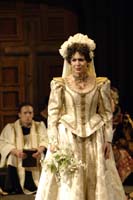 |
| The Taming of the Shrew, directed by Kate Buckley at the Oregon Shakespeare Festival 2007. |
Today, Petruchio would be jailed for Spouse-Abuse. He also doesn’t treat his servants very well! In a Malibu-based staging, they would probably be Undocumented Mexicans…
Kate Buckley does put a bit of a Psychological-Spin on the plot to explain visually why Kate is so filled of Rage.
Although the text describes her worthy father, Baptista Minola [Jeffrey King], as an extremely wealthy Merchant of Padua, Buckley has him making some petty-cash on the side by operating a Trattoria—in which Kate seems to be slaving-away comme une chienne, while her lovely sister Bianca [Sarah Rutan] lounges about, beleaguered by Suitors, none of whom would dare or want to woo Kate. Who must be married first…
Veteran Ashland designer Richard L. Hay has "differenced" the outdoor-theatre’s basic Elizabethan façade—which he also designed—with some charming & colorful Italianate Window-Treatments & other ingenious set-props which quickly establish Mood, Time, & Place.
And David Kay Mickelsen’s handsome costumes add to the Period & Comedic Effect. The skillful lighting was created by Robert Peterson, with special music by Todd Barton, also responsible for Sound-Design.
Others of note in the large cast: James Edmondson, Danforth Comins, Shad Willingham, Jeff Cummings, Mark Bedard, & Petruchio’s much-abused servants, Tasso Feldman & Robin Goodrin Nordli—amazing in a hilarious male-role.
[Tasso Feldman’s home-town is Thessaloniki, in Northern Greece—close by Mount Athos—where Your Scribe was recently for the awarding of the European Theatre Prize. I also made a point of visiting the Jewish Museum, for many Sephardic Jews—purged from Spain by Their Most Catholic Majesties, Ferdinand & Isabella—found safe-haven in Ottoman Salonika centuries ago!]
The Tempest [****] |
| The Tempest. Scenic Designer: William Bloodgood. Costume Designer: Deborah M. Dryden. Lighting Designer: Robert Peterson. Photo by T Charles Erickson. |
On the Short-List of Shakespeare’s Plays that Your Scribe would rather not see again any time soon—headed by Twelfth Night & Midsummer Night’s Dream—The Bard’s Tempest is somewhere in the middle, with Pericles, Prince of Tyre & Timon of Athens at the bottom.
Not that it is not a Great Play: rather, that I have seen it too many times over sixty-years of play-going & reporting. And have seen it too often in less-than-challenging productions.
Even in an ingenious, innovative, & insightful new staging of The Tempest, getting through all that business with the ship-wrecked Evil Duke of Milan & the almost Eviler King of Naples is a Slog. Not to overlook all that ho-hum Comic-Business with Stephano, Trinculo, & Caliban.
When—at the Close, after Prospero has already
tied up all the plot’s Loose-Ends—he invites his Former But Now
Forgiven Foes into his Cave to speak at Greater Length
about these Magical Matters, one is grateful that Shakespeare
did not write yet another Act, featuring these promised Remembrances
of Plots Past.
In retiring Oregon Shakespearean Festival Artistic-Director Libby Appel’s Valedictory-Production of The Tempest, however, there was at least one Outstanding Insight that was worth the entire evening for Your Scribe: the empathetic interpretation of Caliban, plaintively but powerfully played by Dan Donohue! I have never before been so moved & impressed by the character & sufferings of this Primitive, exploited, excoriated, & enslaved by the supposedly Goodly Prospero.
Yes, Prospero has not only been Greatly Wronged—in having his Dukedom taken from him—but his Disappearance & Death has also been desired by his Very Own Brother!
But this possibly Educational-Experience has not prevented him from effectively enslaving both Caliban & Ariel. That they are not Human-Beings in the Mainland-Italian Sense may have been well understood by Shakespeare’s Audiences. But it is now not Politically-Correct, so a really admirable Prospero should now Know Better.
Libby Appel‘s Prospero—the commanding Derrick Lee Weeden—does suggest that he has indeed learned something on the Enchanted Island. But it doesn’t concern Caliban. Instead, he comes to realize that Revenge Is Not the Answer in dealing with his Usurpers.
That, of course, is in the play-text, but Weeden’s Prospero demonstrates Forgiveness as a Learned-Lesson. He also has an amazingly beautiful Magician’s Cloak, thanks to costume-designer Deborah M. Dryden—whose other Period-costumes are almost as handsome.
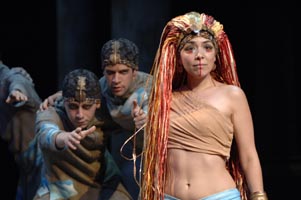 |
| The Tempest, directed by Libby Appel at the Oregon Shakespeare Festival 2007. |
Designer William Bloodgood has provided only a few white-weathered tree-trunks to "difference" the basic Elizabethan stage-façade, but this Elemental Decoration is adequate & does not impede the stage-action.
For no reason I can fathom, Appel has chosen to transform Prospero’s Usurping Brother, Antonio, into a Sister, Antonia, who has made herself Duchess of Milan—which seems an unlikely Order of Succession in Milan. Women’s Rights in Renaissance Italy?
Nancy Rodriguez, as Ariel, proves to be a Bird of Many Colors. And she is supported by a group of Sprites, some of whom seem to have trained with Cirque du Soleil. They improve on Shakespeare’s indicated Masque by interpolating a Sonnet: Let me not to the marriage… And a fragment, as though the Original needed Improvement.
At least we were not treated to: How do I love thee, let me count the ways…
John Tufts was a Tom Cruise-like Ferdinand, with Nell Geisslinger the essential ingénue-Miranda. Others of Interest in the cast: James Edmondson, Christopher DuVal, Michael J. Hume, & Armando Durán.
Romeo & Juliet [****]It was Tom Cruise Time again in Bill Rauch’s New Look at the Classic Drama of Doomed Love, Bill Shakespeare’s Romeo & Juliet. John Tufts was a Loving Fury, to the somewhat tamer Juliet of Christine Albright.
Although Albright was fortunately not channeling Lindsay Lohan, her readings of some of the Bard’s most affecting poetic flights were not as Passionate or as Powerful as they might have been.
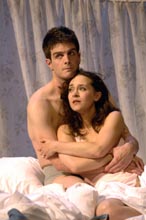 |
| Romeo and Juliet, directed by Bill Rauch at the Oregon Shakespeare Festival 2007. |
Bill Rauch is the new Artistic-Director of the OSF, so many Ashland Regulars were eager to see what might be in store for them in future seasons. He certainly didn’t Play It Safe with this production.
And it is good that he did not offer a Conventional Replica of an Elizabethan Staging—all Handsome Costumes, Excellent Diction, & Elegant Poses—as is too often the case. Actually, the Diction-Thing is handled much better by the Brits than the Yanks. Even in the Rogue River Valley, where some of the lines occasionally emerge with a mushy-quality.
Rauch’s Very Original Concept was seeing R&J as a Generation-Gap Love-Tragedy. Rather than as an extension of the Tragic Contention between two Ancient Veronese Feudal-Families…
For Bill Rauch—aside from their Unexplained Quarrel: What was that all about? Is it mentioned in the play-text?—the Capulets & the Montagues are very much Alike: in Station, in Wealth, in Power, in Familial Self-Regard…
What is Different is the Emerging Spirit of the C&M Teen-Agers, beginning to cast off Age-old Hatreds. Or, much worse, imitating the angry, senseless Passions of their Prejudiced Elders.
To heighten this visually, Rauch has the older characters attired in the richly-patterned fabrics which make Ashland Costumes a Show in Themselves! But Romeo & his Chums—as well as the Young Capulet Faction—wear English Public-School Uniforms.
[I’ve seen this PSU-costume-updating in a Jonathan Miller production, but it wasn’t R&J, rather The Mikado. And why not? But it won’t work for Hamlet, even if they might have had School-Uniforms at Wittenberg University…]
Benvolio [Juan Rivera LeBron] knows how to kick a soccer-ball, but DJ Mercutio [Dan Donohue]—in blue-jeans, with tattoos on his neck—seems from the Other Side of the Verona Tracks.
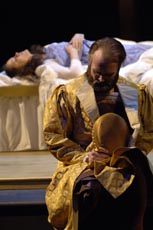 |
| Romeo and Juliet. |
But when Romeo & Friends go to the Capulets’ Ball, they are all attired in smart leather versions of Renaissance Attire, plus Masks, including a Batman vizard. Shigaru Yaji gets full-marks for ingenuity in costume-design!
Fortunately, Friar Laurence [the veteran Mark Murphey] was not dressed like a Catholic Youth Organization Parish-Priest, but in Regulation Franciscan Habit. Murphey was effective in this difficult role, as was Demetra Pittman as Juliet’s babbling Nurse.
The ferocious attack on Mercutio by Tybalt [René Millán] looked really dangerous, not like some elegant Choreography of Sword-play. This violent & fatal encounter was devised & coached by U. Jonathan Toppo.
Christopher Acebo’s elemental set-differencing for the Elizabethan façade includes the suggestion of Prison-Cages & Security-Doors, with a slim metallic Cross rising from stage-floor to the stage-Heavens, within the central pavilion, but toward stage-right. The Balcony-Scenes are staged, first, from a stage-left upper-window, then on the central pavilion’s balcony.
More prominent, however, is the central downstage Trap, which serves as Friar Laurence’s Cell, Juliet’s Marriage-Bed, & the Capulet Tomb. These rising & sinking locations help keep the plot marching along—without the fuss of moving chairs & props on the Balcony.
Again, the lighting of Robert Peterson worked very well—both Light & Shadows—in the production.
Curiously—for me at least—Shakespeare’s Poetic Passions seemed soaring at first. But, as the evening progressed, they seemed to lose some of their Power & Pathos in the delivery… There was a lot of Energy onstage through-out, but something of the Epic Sadness of the deaths of the Doomed Lovers seeped somehow slowly away.
Curiously, the Passionate Variations on Falling in Love—and Maintaining that State—in As You Like It seemed much more Believable than in the OSF Romeo & Juliet. Of course, they are two quite different Dramatic-Genres: Comedy vs. Tragedy.
But Shakespearean Tragedy should always have more power over Audience-Emotions than the Bard’s Comedies, should it not? When this does not seem to happen, it is surely not the fault of the plays themselves. Or is it?
Both the OSF AYLI & the R&J were informed by Abundant Energy in the two acting-ensembles. But it seemed more Character-Focused in the former production. Your Scribe is not, in fact, a Big Fan of AYLI—with all those Pairs of Lovers & Letters on Trees—but J. R. Sullivan’s enchanting production made me a Convert!
I have, in my time, seen Magisterial & Theatre-Historical Productions of As You Like It, staged by such Notables as Peter Hall & Peter Brook. But this was the first time I found myself really Caught-Up in the Romantic Concerns of Rosalind & Orlando [Miriam A. Laube & Danforth Comins], Touchstone & Audrey [the hilarious Song-&-Dance-Man, David Kelly & the sluttish Teri Watts], & even Silvius & Phebe [Juan Rivera LeBron & Sarah Rutan].
Scenic-designer William Bloodgood’s Basic Black Industrial-Warehouse setting was very effective for focusing attention on the Players & the Play. Minimal Means for Maximum Effect. And, as the Lovelorn Characters penetrated deeper & deeper into the Forest of Arden, great green Translucencies of Leaves slid on & ever on.
The Famous Fight between Charles the Wrestler [Todd Bjurstrom] & the Lightweight Challenger, Young Orlando, looked really dangerous, thanks to the skills the performers & of U. Jonathan Toppo, as OSF’s Official Fight-Choreographer.
Costume-designer Joyce Kim Lee matched Modern Outfits with the Modern Minimalism of the setting. Touchstone could have been Laurence Olivier, in John Osborne’s The Entertainer. Rosalind wore bib-overalls in Arden, even though her lines specified she was wearing doublet & hose…
The entire cast was admirable, with special plaudits to Robert Sicular as Jacques & Julia Oda as Celia. Mark Murphey was the trusty Old Adam—a fugitive from The Grapes of Wrath.
Tom Stoppard’s On the Razzle [*****]Most American theatre-buffs know this historic farce as Hello, Dolly! But it is best-known in Mittel-Europa as Einen Jux will er sich machen, a lively comedy by Vienna’s Johann Nestroy, who described it as a Posse mit Gesang.
But Nestroy borrowed the plot from John Oxenford’s English original, A Day Well Spent. It was turned back into English by Thornton Wilder, first as The Merchant of Yonkers and later as The Matchmaker. Followed, of course, by Carol Channing as Dolly Levi!
Between ingenious Dramatic Inventions, Stoppard has occasionally tried his talent at adaptations of, or variations on, earlier classics: Vide: Rosencrantz & Guildenstdern Are Dead, plus a reworked Molnar comedy, now known as Rough Crossing.
In On the Razzle, Stoppard returned to Nestroy’s plot & characters, proving himself a much wilder Re-write Man than Thornton Wilder. Not only does he leave the show in Vienna & its Suburbs—rather than transport it to Yonkers & Manhattan—but he also improves on both Wilder & Nestroy with Insidiously Clever Word-Plays & Outrageously Suggestive Double-entendres.
Director Laird Williamson’s Handsome & Supercharged Ashland vision of On the Razzle is well worthy of Broadway, but its Production-Values are almost superior to what audiences are accustomed-to in New York. And Williamson keeps the frantic pace of Stoppard’s visual & verbal farce racing along from one Near-Disaster to the next High-Jinx.
Designer Robert Blackman’s splendid Period Costumes rival the often delicious inventions of Tony-winner William Ivey Long! And Michael Ganio’s many-windowed-rear-façade provides an intriguing backdrop for a variety of clever set-pieces & props which not only amusingly establish specific-locations, but also are effectively used for hilarious visual-comedy.
"Aside from the sets & costumes, Mrs.
Lincoln, how did you like the show?" [Actually, this should read: "Aside
from that, Mrs. Lincoln," referring to her husband’s Assassination
in the Presidential
Box in Ford’s Theatre…]
Nobody gets killed in Ashland’s On the Razzle, but there’s always the immediate danger of Fatal Collisions. The reason Your Scribe opens this report with a rousing salute to the show’s Designers is that he has been writing about stage-design for almost half-a-century for Theatre Crafts, Entertainment Design, & other tech-oriented publications.
Some Drama Classics can be done on a bare-stage—"Two Planks & a Passion"—but Farces need ingenious sets & even more effective set-props. Even before the French Farces of Feydeau, Nestroy needed multiple-doors and closet-hiding-places.
Nor do Stoppard & his Ashland designers disappoint in this regard.
Nonetheless, the Play’s the Thing—and the sets & costumes would be only Theatre-Museum-Pieces, if they were not animated by an Outstanding Cast. At the helm is Tony DeBruno as Zangler, the Premier Provisioner of High-Class Veggies & Condiments to the Bon Ton of Vienna.
He is trying on the splendid new Uniform w/Boots & Spurs he will wear in the Grocers’ Guild Parade on the Ringstrasse, while trying to foil the Impending Abduction of his Niece [Terri Watts] by a handsome young Belgian Fortune-Hunter [Shad Willingham] and, at the same time, win the hand of his Fashionista Fiancée, Mme. Knorr [Suzanne Irving].
Zangler is leaving his suburban Provision-shop in the care of his clerk, Weinberl [Rex Young], & his lively apprentice, Christopher [Tasso Feldman]. As he thinks—but they have other ideas: Off to Downtown Vienna for a Razzle!
Others in the cast worthy of note: G. Valmont Thomas, as a "classic" valet; Terri McMahon, as a lovely lady who becomes entangled with the penniless Weinberl, & Eileen DeSandre, as Zangler’s Housekeeper, a doll-like creature who keeps popping out of a set-side-door, rather like one of those Weather-Clock figurines.
This is an entirely engaging show that ought to be seen—if not on Broadway—at least at Washington’s Kennedy Center & Brooklyn’s BAM, which seldom plays host to Impressive American Productions—preferring Brits & Continentals…
When was the last time you read a novel by California’s William Saroyan? Or saw one of his plays—such as The Time of Your Life? Or The Cave-Dwellers?
His American-Armenian brand of Incurable Optimism was very popular as America’s Great Depression disappeared into World War II. Saroyan’s The Cave-Dwellers was recently & briefly revived Off-off-Broadway in New York, but there has been no rush to recreate Time of Your Life for Major Stages.
His work has long been surpassed by the insights of the likes of Philip Roth & Saul Bellow, not to mention the Imaginative Ingenuities of the late Kurt Vonnnegut, Jr.
But perhaps Saroyan’s Time Is Coming?
The Oregon Shakespearean Festival has premiered Tracy’s Tiger, a potentially charming new musical, based on Saroyan’s Novella of the same name. The show’s book includes "additional material" from his short-story, The Barber Whose Uncle Had His Head Bitten Off by a Circus Tiger. A very Saroyanesque title, indeed!
This is a Group-Effort of Linda Alper, Douglas Langworthy, Penny Metropoulos & Sterling Tinsley. Alper, Langworthy, & Metropoulos had previously collaborated on The Three Musketeers for the OSF’s 1999 Season.
Thomas Tracy—the Anti-Hero of the musical—is always accompanied by an Invisible Tiger. [Calvin & Hobbes is Post-Saroyan, so they can’t sue!]
On San Francisco’s Embarcadero, Tom meets a sweet young girl, Laura, who has her own Personal Tiger. And thereby Hangs a Tale, which the Creative Team have moved from its original New York to Saroyan’s San Francisco.
They have also invoked almost every Place-Name in the Sacramento Valley—except for my hometowns of Grass Valley & Nevada City. Oddly enough, they do not cite the town of Tracy—near Stockton—which may have been Saroyan’s inspiration for his hero’s name.
In fact, the plot-action is so Frisco-Friendly & Period-Oriented that it might just Alienate someone who has never had ice-cream at the Ghirardelli Chocolate Factory or taken rides on Muni Cable-cars & buses.
Also, in the first act, Tom Tracy [Jeremy Peter Johnson] is so aggressively annoying—Tiger & All—that it was difficult for Your Scribe to be interested in his varied Failures & Fuckups. Nonetheless, there are some engaging-songs & potentially-interesting situations.
This Act Needs Work!
But the second part really begins to engage interest, especially when the Tiger gets loose—even visible—provoking Zodiac-Panic & providing renewed opportunities for character-interactions & some even more charming songs than in Act One.
This could be the start of Something Big. It’s not Spring Awakening, but then Bill Saroyan was no Frank Wedekind.
Penny Metropoulos staged, with a flexible Unit-Set by Ashland Old-Timers William Bloodgood & 1930s period-costumes by Deborah M. Dryden.
Metropoulos was able to assemble an attractive ensemble. In addition to J. P. Johnson, also on the Embarcadero or nearby were: Laura Morache, René Millán, David Kelly, Brad Whitmore, Michael J. Hume, Miriam A. Laube, Nell Geisslinger, Richard Farrell, Linda Alper, & Juan Rivera LeBron.
Some of Sterling Tinsley’s tunes could well have a Life apart from this Promising Property!
In Cedar City: The Utah Shakespearean Festival—Unlike Ashland—which opens its Summer Season in June with three Production-Premieres in the outdoor Elizabethan Theatre—in Southern Utah, the season begins with Six Premieres in the same week!
Both logistically & artistically this is a very Big Challenge: To unveil three Shakespeare dramas—almost simultaneously—as well as three other plays of Later Vintage is a Feat the Oregon Shakespearean Festival has never attempted.
Nor, in fact, has any other American Regional Theatre ever set itself such a challenge. Even in New York this past season, the Lincoln Center’s Vivian Beaumont ensemble premiered Tom Stoppard’s Three-Part-Russian-Revolutionary-Epic, The Coast of Utopia, seriatim.
Also on the Utah Festival program—but set to open later in the season—are Shakespeare’s The Tempest, plus Yasmina Reza’s Art & Agatha Christie’s The Mousetrap.
Utah’s annual trio of Shakespeare Productions are presented in its own open-air Globe-Theatre-approximation, a Memorial to the Adams Family, early Theatre-Pioneers in Utah. Their Scion & Heir, Fest-Founder Fred Adams is still very much a Presence at the Festival. R. Scott Phillips is now the genial & capable Festival Director.
The more Secular play-productions are mounted indoors in the nearby Randall L Jones Theatre. This handsome modern playhouse is the initial Major Component of an envisioned Festival Center Precinct.
The Adams "Globe" is to be either moved from its present site—on the University of Southern Utah Campus—or re-constituted on the Festival-Owned-Territory.
For Your Shakespeare-Scribe, typing that title—The Adams Globe—brought back memories of yet another Adams Globe. This one, however, sited at Hofstra University, on Long Island, New York.
[When I returned from four years teaching for the University of Maryland Overseas, Hofstra—and neighboring Adelphi College—were my initial lecture-ships.
[Hofstra’s President—John Cranford Adams—was a Shakespeare-Scholar & had written a book about his Ideational-Concept of Shakespeare’s Second Globe. He was so sure of his Theories that he had caused the Drama Department to construct a Replica which was inserted into the Hofstra Theatre’s Neo-Art-Deco Proscenium every spring for the Hofstra Shakespearean Festival!
[This brief Fest was presided over by the late Bernie Beckerman, who had also written a book about The Globe Theatre. It was a revision of his PhD Thesis—and why not?]
Since the Globe Studies of Adams, Beckerman, & even those of the late & venerable C. Walter Hodges were written, however, previously-prevented Excavations on the South Bank of the Thames—notably those of the Foundations of the Rose Theatre & portions of the Historic Globe, now covered by Post-Modernist-Condos—have disproved some earlier Theorizing.
But even Sam Wanamaker’s Third-Globe-Reconstruction, near the site of the Original, may not be the Definitive-Answer or Solution. Your Roving-Reporter interviewed Sam every summer in London about the Progress of the Project.
I was even asked to contribute a Paper on American Efforts to create Globe Theatres for a Conference at the University of Georgia, convened so Leading Scholars could help Sam’s Architect, Theo Crosbie, design an effective Shakespeare-Stage & Audience-Surround.
At Sam’s behest, my report was published in the 50th Anniversary Program for Harrow-on-the-Hill’s own Globe Theatre, a mock-up installed each year for an All-Boy Bardic-Production in this famed Public School’s Lecture-Arena.
[I was even invited to afternoon-tea by Harrow’s Headmaster & permitted to photograph its Historic Classrooms, where Harrow Boys such as George Gordon, Lord Byron & Sir Winston Churchill had carved their names deeply into the Tudor Paneling!
[And—as I am related to Sir Winston by marriage—I was also allowed to photograph his Portrait at the apex of the "Globe" arena, as the Boys were setting up their own Globe. Explanation: George Cornwallis-West was my grandmother’s first-cousin & he married Brooklyn-born Jennie Jerome—Sir Winston’s mother—after her first husband, Randolph Churchill, died.]
The Utah Shakespearean Festival is not the Only Game in Town. Every summer there is also a Neil Simon Festival. "Doc" Simon may not be in the least Shakespearean, but he is as Prolific. He has 38 Broadway Shows to the Bard’s 37 acknowledged-playtexts. And Simon certainly has made more money as a Playwright.
In fact, the 80-year-old Neil Simon—in terms of income from plays alone, not counting Royalties & Fees from films & TV—may well be the Richest Playwright who has ever lived!
See some of the Simon-Canon in Cedar City this season! It runs from 19 July to 11 August.
Simon-Festival Festival-Director Richard Bugg has programmed Plaza-Suite, The Prisoner of Second Avenue, & The Odd Couple. These productions are presented in the handsome new Heritage Center Theatre, near the Utah Shakespeare Venues.
Essentially, these Simon Revivals do not really compete—or interfere—with the USF stagings. Rather, they Augment & Extend the Play-Possibilities for the hundreds & hundreds of theatre-lovers who flock to Cedar City every summer.
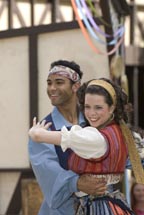 |
| Green at the Utah Shakespeare Festival, 2007. |
The USF also programs morning Literary-Seminars under the Cedars, afternoon & evening Pre-play Orientations in the Auditorium-Theatre adjacent to the Globe, plus lively Green-Shows of Tudor-Inspired Dance & Song.
Then there are all those Natural Wonders to see, as well as the plays: Bryce, Cedar-Breaks, & Zion National Parks!
The Utah Shakespearean Festival tours an Outreach-Program for schools in Nevada, Utah, Idaho, & Arizona. The highlight is a 75-minute tab-version of a Shakespeare play, complete with sets, costumes, & lighting. In 2006, 65 schools were visited, with student-audiences of over 30,000!
As with Ashland, there is a demonstrable Economic-Impact on Cedar City & Iron County—where it is located. Annual spending by local Arts Organizations & Audiences has totaled some $24.5 million, of which the Lion’s Share is generated by the USF.
Unlike Ashland—which was already an Historic Victorian Town before its Festival began—Cedar City was essentially a Frontier-Junction, with some blocks of houses & a Mormon Stake Church. Virtually a Wide-Spot in the Road…
Even today—unlike Ashland—there are almost no Souvenir-Shops, Craft-Corners, or Fashion-Boutiques. No Gourmet-Restaurant is to be found; the IHOP, KFC, Arby’s, Wendy’s, & Taco Bell franchises all close at 11 pm! Shortly after the Adams Globe productions come to a close as well…
Like its Shakespearean-Sister in Ashland, the Utah Shakespearean Festival has also won the Tony Award© for the Outstanding Regional Theatre! This honor—one of many—was bestowed in 2000. These Off-Camera Tonys are voted on by ATCA—the American Theatre Critics Association. Both Tonys were awarded after ATCA had held Annual Conferences in both Ashland & Cedar City.
This June, the Utah Shakespearean Festival opened with many ATCA critics on hand—including Your Scribe. But many of us were working under a Critical-Handicap: We had just come from an entire week of back-to-back shows on the Vegas Strip: All the Cirque du Soleil you can take…
Really, the past three weeks could be regarded as devouring a Shakespeare-Sandwich! Slices of OSF & USF—with Vegas Shows in between, plus Bellagio-Sauce & Caesar Salad-dressing!
As Your Roving-Reporter has only three days in New York—after Cedar City—before flying-off to Germany for the Hamburg Ballet Festival, the following Production-Notes cannot be as Extensive as I would like.
[Years ago, I was the first American Culture-Journalist to report on the remarkable European Career of Milwaukee’s John Neumeier, Chief of the Frankfurt Ballet & later, founder of the Hamburg Ballet. Last summer, Johnny was sitting in front of me in Wagner’s Festspielhaus, in Bayreuth. Thus, the Invitation to the Dance in Hamburg!]
In the Adams Memorial Shakespearean [Globe] Theatre:
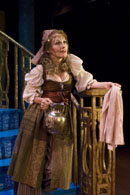 |
| Twelfth Night. |
So, OK… This is one of those Shakespearean Comedies that I had already Seen Too Often way back in the 1970s, when I traveled all over America & Canada to check-out all the Shakespeare Festivals for Theatre Crafts & later for the Book-Report: The Shakespeare Complex.
And when I wrote all the Head-notes for the Houghton-Mifflin Play-Series—Tragedy, Comedy, & Form in Drama—I found I still had Problems with this Gender-Scrambling Comedy of Mistaken-Identities & Characters Who Lack Self-Knowledge—especially in Matters of Love.
As with the Separated-Pairs of Identical-Twins in The Comedy of Errors—the Dromios & the Antipholuses—why does it take so Long for them to figure out why they are mistaken for someone who looks exactly like them?
HaHa! & Hohum!
But my Biggest Problem is with the Politically-Incorrect & somewhat Savage-Mistreatment of the Proud Malvolio, when he is locked in a Dark Chamber & tormented as a Madman.
This may well have been Thigh-Slapping-Comedy for those "Nut-Cracking" Elizabethans, but it is no longer a Laughing-Matter. Even if well into the 19th Century, the Upper-Crust would rush off to Charenton, Bedlam, & other famous Madhouses to be entertained by the Inmates. See Peter Weiss’s Marat/Sade!
Frankly, I’m with Malvolio, when he threatens at the close, the otherwise Happy-Ending: I’ll be revenged on the pack of you!
Shakespeare should have written a Sequel, in which Malvolio does just that!
Nonetheless—despite these Problems with the Play—the new USF staging does have its Own Charms. Not least of which are its Orsino & Olivia, the very attractive & talented Michael Sharon & Carey Cannon. It would be fascinating to watch this Dynamic Duo play both these roles & those of Petruchio & Kate, back-to-back in repertory!
Not having seen a USF production for more than three-decades—but having been an Ashland Regular for almost as long—I was uneasy about the Professional-Level of Shakespeare in Southern Utah.
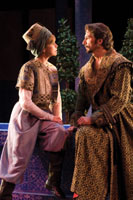 |
| Twelfth Night. |
While USF’s Twelfth Night did not quite have the finish of an OSF staging, it was certainly in most respects Thoroughly-Professional. And Visually-Attractive as well…
Stage-director B.J. Jones—working with the ingenious Set, Costume, & Lighting-Designers Bill Forrester, Janet L. Swenson, & Donna Ruzika—was able to evoke the Adriatic Fringes of the Ottoman Empire, in all its Turkish Orientalia, for the Permanent Elizabethan-Façade of the Adams Theatre’s stage. Just as OSF designers "difference" the Ashland Façade.
As Viola & Sebastian—the Shipwrecked & Lost Twins—Shelly Gaza & Ryan Schabach were indeed youthful & appealing. Uneasily disguised as a young man, Viola fortunately did not have to perform a Gaza-Strip to prove she was really a Fit Mate for the smitten but baffled Orsino.
These Sexual-Confusions must have seemed Hilarious to Globe-Audiences—especially to Shakespeare’s Groundlings. But they still have the power to evoke giggles & guffaws in Cedar City, as well!
Some Shakespeare-Fans now living may remember the Love-Generation’s Musical-Updating of this comedy: Your Own Thing, by Danny Apollinar. Orson managed a Rock-Group called The Four Horsemen of the Apocalypse. Viola/Cesario took the place of Disease, who was sick…
Confused by his Sexual-Attraction to Cesario, Orson—played by Tom Ligon—got a book on Homosexuality, fearing he might be Gay! But that was back in the late 1960s…
I was struck by the general youthfulness of the USF cast—some of whom did not lend authority to their roles as well as others. But this may be all to the good in preparing young performers a Long Way Off from Broadway, not to mention Burbank TV Studios.
Regional Shakespearean Festivals have long been excellent workshops for Interns of all kinds—not just Acting—to Gain Experience & Mature as Performers.
There seemed to be a Vocal-Level Problem, for some players were at times Over-Loud. While some others could hardly be heard in Minor-Moments. But this was Opening-Night, after all. And some of us Senior-Critics surely do have Hearing-Losses.
Automobile-Drivers have to have Eye-Exams, but Drama-Critics are not required to have Hearing-Tests. Is that Right & Fair? Or Fair & Balanced…
Having seen some of the Greatest Actors of the English-Speaking-Stage in Twelfth Night, I was less than astounded—and not much amused—by the effortful Toby Belch, Andrew Aguecheek, & Maria of Phil Hubbard, Michael David Edwards, & Anne Newhall. Each had some Moments, but the Interactions should have been more Effective & less obviously Forced & Farcical…
Coriolanus [***] |
| Coriolanus at the Utah Shakespeare Festival, 2007. |
This challenging drama is nominally a Shakespearean Tragedy. But in a number of moments in Part One of the USF production, the playing of some characters & scenes skidded perilously close to Comedy.
There is certainly a Comic-Potential in the lines & situations of Coriolanus—which is one reason why Shakespeare-Parodies are so easy to devise. But this tendency toward Farce & Coarse-Acting needs to be assiduously avoided, if a Tragic Purgation is to be achieved.
Perhaps Your Scribe has been spoiled by seeing such Greats as Laurence Olivier play Coriolanus?
Nonetheless, for the most powerful Tragic-Effect, the Coriolanus should be a man of some Stature, even Majesty. As they say: The Bigger They Are, the Harder They Fall.
Unfortunately, stage-director Henry Woronicz—formerly of Ashland’s OSF—had to cast a small slim actor as Coriolanus, a player who was almost dwarfed by Roman Senators & Soldiers.
Not only was this fabled & fearless Roman Warrior-General slight of build, but his frequent Rages & Tantrums at the Traditional Demands of the Roman Citizen-Rabble—and their obviously-scheming Tribunes—seemed more like the Petulance of a Spoiled-Child than the Understandable-Anger of a Great Heroic Defender of Rome’s Honor & her People.
At times, he seemed more like a Screaming-Shrew, than an Ego-Driven Leader of Men. He even seemed to stamp his feet in petty-disappointment, like an Injured-Spinster.
Of course, Coriolanus is his Mother’s Boy—and that proves his Ultimate-Undoing.
When he is Exiled from Rome—rather than being executed for Treason against the State—his Blind Fury & Thirst for Revenge are so great that he goes over to his & Rome’s Greatest Enemies, the Volces. This is Stupid, Dangerous, & Vicious in the Extreme: not the best Course of Action for an unjustly Discredited Hero.
In lesser-degree, the Grecian-Hero Ajax—convinced he had been dishonored by his fellow-warriors—decided to slaughter them all. Coriolanus seems his Successor, less Simple than Ajax, but just as childishly & murderously petulant…
But the Mad Folly of Coriolanus’ Fatal-Decision would seem so much more terrifying were he a more Magisterial figure. This would also make his Emotional-Collapse & Capitulation—when confronted by his desperate Mother, Volumnia, begging him to spare Rome from Savage Destruction—all the more powerful & pathetic.
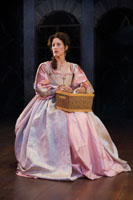 |
| Coriolanus. |
Visually & Emotionally, the role of Coriolanus cries out for an Olivier, not a short, slight, & short-fused chap. Not that the actor cast is not an able performer: he certainly has a kind of Charisma, but it doesn’t work in this role.
True enough, both Julius Caesar & Napoleon Bonaparte were men of Small-Stature. And also equipped with Egos even larger than that of Coriolanus. But it is difficult to imagine either of these Imperial-Types—at least as they are known from History & Folklore—behaving as rashly as Volumnia’s out-of-control Boy.
Well, yes, there was The Retreat from Russia, followed by Napoleon’s Definitive Waterloo…
Outstanding in this production was Michael Sharon, as Aufidius, General of the Volces & Mortal-Foe of Coriolanus. Leslie Brott was a properly Noble Roman Matron as the manipulative Volumnia.
Dan Frezza played the aged Agrippa, Coriolanus’ defender to the last, with Michael David Edwards & Raymond L. Chapman as the treacherous, insidious Tribunes of the Roman People.
James Newcomb is an actor with both Energy & Presence. He is also clearly Intelligent & Passionate in performance. But he doesn’t Look quite right for Coriolanus. How about Osric? Or even Hamlet, perhaps?
The elemental set-differencing of the Tudor-stage-façade was designed by Bill Forrester, with costumes & armors by Claudia Stephens.
King Lear [*****]Hamlet & King Lear are Definitive-Summits for American Actors to Climb. Not only do most lack the Articulative-Clarity of their British Peers, but both Yanks & Brits are usually not yet Old-Enough or Wise-Enough to do these Towering-Roles the Justice they demand, when the Opportunity to play them arises.
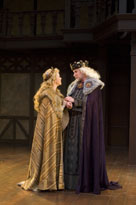 |
| King Lear. |
Even Lord Olivier felt that Disparity: when you are a young actor, you have the Energy & Stamina for Lear, but you do not have the Life-Experience that can Illuminate your Interpretation of the Role of Roles…
The popular & much-admired Kevin Kline demonstrated that recently in his Lear at New York’s Public-Theatre, once the Indoor-Shrine of Joe Papp’s NY Shakespeare Festival. But now fallen on hard, bleak days…
Kline’s Interpretation seemed Intelligent—even if the Concept of his director did not—but he was generally judged Too Lightweight for the role by many NY Critics. But then, most of them were Waiting-in-Ambush for Kline to Divide His Kingdom…
Consider, then, the Alpine-Heights the estimable Dan Kremer has to climb at the Utah Shakespearean Festival. Every third Play-Night, he embodies Lear, having impersonated Horace Vandergelder on a previous afternoon!
In the earlier scenes of the tragedy, there seemed to be more Heroic-Bellowing than Engaged-Passion. In fact, the sameness of the scenes became a bit boring. Some nearby critics left at the Interval.
But with the Blinding of Gloucester, the confrontations Caught-Fire. Lear’s Madness was truly Moving, as were the encounters between Poor-Tom/Edgar & his faltering Father, Gloucester, and between Lear & Cordelia.
Although Cordelia looked rather like a candidate for Legally Blonde: The Musical, she was finally very affecting, dead & lovely, in the dying Lear’s arms!
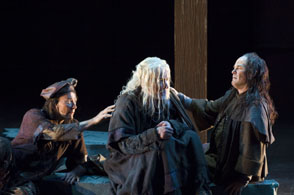 |
| King Lear at the Utah Shakespeare Festival, 2007. |
Despite James Newcomb’s misadventures as Coriolanus, he is well-suited to the role of Lear’s stalwart protector, Kent. The Myopic—and too soon Blind—Earl of Gloucester is effectively interpreted by Kieran Connolly, with Shawn Fagan & Raymond L. Chapman as his Good & Evil Sons, Edgar & Edmund.
Lear’s Daughters form an Unlikely-Trio, as played by Carey Cannon, Carole Healey, & Shelly Gaza, as Regan, Goneril, & the Elementally-Unwise Cordelia. [Look, Girlfriend! You know what your Doting Old Dad wants to hear you say, so say it Out Loud, good & clear!]
Others in director J.R. Sullivan’s large cast include: Craig Lee Thomas as Burgundy, Ryan Schabach as the King of France, Phil Hubbard as Cornwall, John Oswald as Albany, Jed Petersen as Oswald, & Timothy Casto as Lear’s Fool.
This is surely one of the Bard’s most Challenging-Fools for any actor. Unfortunately, this USF Fool-in-Drabery did not Stand-Out as ironically & bitterly as he might have: He tended to blend…
Design-credits are shared among Bill Forrester/set-differencing—which was largely a matter of Thrones & Chairs, David Kay Mickelsen/costumes, & Donna Ruzika/lighting. Joe Payne doubled as Composer & Sound-Designer…
In the Randall L. Jones Theatre:
Thornton Wilder’s The Matchmaker [Preview]
Even before seeing Ashland’s production of Tom Stopppard’s On the Razzle, I knew I was going to see Thornton Wilder’s adaptation of Johann Nestroy‘s original Viennese Posse mit Gesang in Cedar City. I was already wondering how either—or both—of them would fare in Western-Regional-Productions.
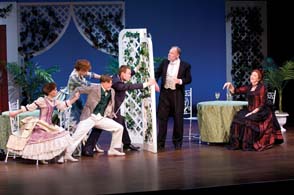 |
The Matchmaker Preview at the Utah Shakespeare Festival, 2007. |
Both Ashland & Cedar City are a long way off from both Broadway & Vienna, after all. And the Playwriting-Skills & Weltanschauung of Wilder & Stoppard are rather different. Not to mention their respective Wit & Way with Words. Stoppard has Wilder beat hands-down…
One of the reasons Wilder is now so seldom revived is that there is a certain Middle-American or New-England Folksiness & Optimism in most of his quasi-Philosophical dramas that now seem Dated, even Maudlin & Misguided. [The bitter, spare Cemetery-Scene in Our Town excepted, of course…]
Also, Wilder’s Narrative-Device of having Characters—like Dolly Levi & Sabrina—step out of the plays to share their Thoughts & Dreams with the Audience—in the manner of Shakespearean Soliloquies & Restoration Asides—may now seem rather Naïve or Worn.
When the Stage-Manager in Our Town first told Broadway Spectators Who & What they were going to see—not to mention Where the characters were & How they felt—it was An Astonishment, even though it was already an Ancient-Device. It also saved a Bundle of Bucks on Stage-Sets!
And when Sabrina—played by the indomitable Talullah Bankhead—came before the curtain to complain that the Playwright’s Script made no sense at all to her, audiences were Comically Forewarned that Skin of Our Teeth would be a Satiric-Human-Comedy—ranging over the Ages—quite unlike anything by William Saroyan, the Leading Armenian-American-Optimist of the Time, had to offer.
[In the Wake of World War II—with Germany in Ruins—Wilder’s Surreal drama, germanized as Wir sind noch einmal durch gekommen was a very welcome Hope for the Future!]
Translating Wilder’s Skin of Our Teeth into German could be seen as returning the Dramatic-Favor of his translating & adapting Nestroy’s Viennese comedy, Einen Jux will er sich machen, into The Merchant of Yonkers and, later, revising it as The Matchmaker.
 |
| Preview of the Matchmaker. |
Most Americans now know this Historic-Property as Hello, Dolly! But the USF has given The Matchmaker a New Lease on Life. Indeed, even in Previews, it looks like a lively & colorful production that could tour with Profit both to Viewers & Producers!
With much leaner Production-Budgets than Ashland’s, director Roger DeLaurier & designers Michael Carnahan/sets, K.L. Alberts/costumes, Cynthia Stillings/lighting, & Jeff Mockus/sound have, nonetheless, created comically-attractive Yonkers & Manhattan-Scenes.
These do not have the Broadway-finish of On the Razzle, but they are both evocative of the Gilded Age & cleverly-designed for rapid-scene-shifts.
Dan Kremer is excellent as the Cardiac-Attack-Threatened Martinet-Merchant Horace Vandergelder, equally matched with the splendid Dolly Levi of Leslie Brott. And George Walker is a handsome Artist-Suitor for Horace’s niece, Ermengarde, skittishly played by the attractive Emily Trask.
As Horace’s lovelorn clerk, Cornelius Hackl, Eric Van Tielen is a young charmer & already an Emerging-Master of Comic-Timing. As is Tony Carter, as Horace’s much-abused Apprentice, Barnaby.
Both the beautiful Irene Molloy [Jill Van Velzer] & her cute shop-girl Minnie Fay [Tro Shaw] are fit Comic-Foils for Cornelius & Barnaby.
There is a lot of Knockabout-Physical-Farce in this USF staging, possibly more than Wilder might have intended. It looks at times like a Feydeau Parisian Farce without enough Doors!
But this was a Preview Performance—before the Pace had been Picked-Up & all the Movement-Interaction-Kinks worked-out. This High-Energy Show promises well for the summer!
Bernard Shaw’s Candida [Preview]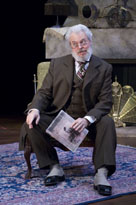 |
| Bernard Shaw's Candida at the Utah Shakespeare Festival. |
Although the USF Candida staging was still in Previews, it had the Look, the Pace, the Wit, the Power, & the Passion of a Major Broadway Revival!
In fact, it was more Professional, more Engaging, & more Thought-Provoking than many a Manhattan revival of a Modern Classic at the Roundabout, the Mint, or the Vivian Beaumont at Lincoln Center.
Even in Previews, I don’t hesitate to rate this Candida at my Top: [*****] Canada’s Shaw Festival—in Niagara-on-the-Falls—should be proud to present a production of this Quality & Intelligence!
Anne Newhall was an entirely fascinating, entrancing Candida, with Donald Sage Mackay splendid as her baffled Vicar-husband, James Morrell: A Spell-Binding, Social-Activist Parson, for once at a Loss for Words…
But Shawn Fagan’s Marchbanks was a veritable Hand-grenade of Passionate-Poetry, Exploding-Expletives, Frantic-Physicality, Truth-Telling, & Neurotic-Need.
Bernard Shaw’s Eugene Marchbanks is one of those Lower-Summit-Challenges that young actors would be willing-to-kill for the opportunity to play the role—before they tackle Hamlet. Fagan is one of the best Marchbanks I’ve ever seen—and I have seen quite a number of aspirants. He is also Edgar in King Lear…
Also admirable in this USF Candida are Melinda Parrett as Prossy, Kieran Connolly as Burgess—Candida’s Exploitive-Industrialist-Dad, & Jed Peterson, in the Minor-Canon role of the Rev. Alexander Mill.
Although Shaw’s comedy is essentially about the Wit & Wisdom of a Woman & Wife—confronted with the Loves & Needs of a Man & a Boy, both of whom Lack Understanding—there is also a whiff of Modern Relevance in Burgess, who has met demands for Higher Wages for his Women-Workers by Raising their Wages & then Replacing them with Machines.
Director Kathleen F. Conlin has achieved an Amazing Staging in the handsome William Morris-style setting of Michael Carnahan. This is Museum-Quality Set-Decoration! Bill Black’s elegant but understated Edwardian-Costumes complement the Morris & Liberty Look.
Even more than USF’s The Matchmaker, this Candida should be more widely seen.
How about a visit at the Kennedy Center?
Lend Me a Tenor: The Musical [Preview]It is the Height of the Great Depression. With hundreds of Unemployed & Homeless in the streets—not shown onstage—should Cleveland even aspire to maintain a Grand Opera?
Cleveland? You must be Joking! Isn’t just having Severance Hall enough?
In Ken Ludwig’s hilarious Opera-Spoof, Lend Me a Tenor, apparently the Operatic-Aspirations of some almost deluded Clevelanders are not to be frustrated. No matter what kind of Farcical-Disasters occur.
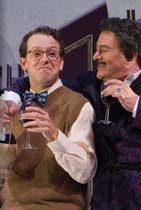 |
| Preview of Lend Me a Tenor. |
Now this multi-Award-Winning Broadway Hit has been turned into a New Musical, entitled—appropriately enough—Lend Me a Tenor: The Musical. And its World Premiere took place not far from Bryce Canyon & Zion National Park at the Utah Shakespearean Festival.
Peter Sham devised the Book & Lyrics—with Ken Ludwig’s enthusiastic approval—with a score by Brad Carroll. It is, in effect, the Ludwig play—Feydeau-French-Farce-Doors & All That—with some Attractive and/or Cute Songs, such as Before You Know It, Be Youself [sic], You Were the One, Lunatic at Large, & Lend Me a Tenor, of course.
Cast & directed by Roger Bean, the Acting/Singing-Ensemble was effectively galvanized by Joe Vincent & Jered Tanner, as Henry & Max—the Producers-like Producing-Duo of the putative Cleveland Grand Opera. Max has always wanted to sing Opera: Otello is on the Marquee, but will it actually be performed?
As Tito Merelli—the Contracted-Tenor, who has contracted a Performance-Threatening Illness—Steven Stein-Grainger was Italianately-Amusing. As was his angry wife, Maria, sung by Melinda Parrett.
But the most surprising vocalizing came from Jered Tanner as the mild-mannered Max: too shy & self-effacing to win the love of his Opera-boss’s daughter. And even more fearful of subbing for the ailing Tito, even though he knows Otello’s role by heart.
The Visual High-Point was having not one, not two, but THREE OTELLOS on stage in Full-Costume & Blackface Makeup at the same time—with the Seven Farce-Doors constantly springing open & slamming shut.
Others of note in the cast included: Jill Van Velzer, Jane Noseworthy, Scott Reardon, & Eric Van Tielen.
This is a lightweight & charming musical. As the play of Lend Me a Tenor already won Broadway’s Heart, how much more might Tenor appeal, saying it with Music!
Of course the Show Needs Work: that’s why it has premiered in Southern Utah—where it has been In-Process for over two years! It breaks no new Compositional or Dramaturgical-Ground, but Older Audiences would surely welcome a bright, high-spirited Conventional-Musical-Comedy like Lend Me a Tenor.
Incidental Intelligence: When Lend Me a Tenor was on Broadway, its handsome Art Deco Sets & elegantly outrageous Art Deco Costumes won it the Art Deco Award of the Year, awarded by the Art Deco Society of New York. It also won a couple of Tonys©.
If the Idea of a Cleveland Grand Opera seems a Preening-Conceit, Get Over It! How about the Utah Festival Opera in Logan, Utah—northward from Cedar City?
This is the 15th Season, featuring Il Trovatore, Porgy & Bess, Showboat, Most Happy Fella, & West Side Story! Not exactly a Metropolitan Opera Repertory Line-up—but, hey! This is Utah!
By the way, Utah’s Pioneer Theatre Company has announced its 2007-2008 Season: A Midsummer Night’s Dream, Paint Your Wagon, The Producers, Doubt, The Heiress, The Foreigner, & The Vertical Hour.
Some Summer Shakespeare Festivals:The Chicago Shakespeare Theatre ensemble has just been to Manhattan, with their Puppet-Macbeth. Washington DC’s Shakespeare Theatre Company continues its 2006/2007 Season with a new production of Hamlet, opening this June.
[If Macbeth is preferably called "The Scottish Play," to avert Bad Luck on-stage, why not call Hamlet "The Danish Play," as it has proved a trap for many an ambitious actor?]
This summer, the Colorado Shakespeare Festival is celebrating its 50th Anniversary! In fact, the Inaugural Production in the Mary Rippon Outdoor Theatre was Hamlet…
Your Roving Correspondent wasn’t on hand for that staging, but he did check-out this Mile-High Festival some years ago when he co-wrote & edited The Shakespeare Complex, with Theatre Crafts Editor, Patricia J. Mackay.
Passing through Boulder, Colorado, in May—too early for this summer’s offerings—he did, however, drop by the Mary Rippon Theatre to pick up a Golden Anniversary Program. The season will run from 22 June to 18 August.
Shakespeare will be represented by productions of A Midsummer Night’s Dream, All’s Well That Ends Well, & Julius Caesar.
CSF’s new Artistic Director, Philip Sneed, knows audiences may love the Bard, but they also like a little Dramatic Variety. So he has also programmed Mark Brown’s play-of-the-same-name, based on Jules Verne’s Around the World In 80 Days, and Carlo Goldoni’s The Servant of Two Masters, as adapted by Connie Congdon.
For tickets Phone: 303-492-0554 or log-on: www.coloradoshakes.org!
The famed New York Shakespeare Festival—founded by the late Joe Papp—opened in Central Park’s Delacorte Theatre in June, with Romeo & Juliet, featuring a Juliet Capulet from Six Feet Under. Very appropriate, considering where she ends her Brief Life in this drama.
Copyright Glenn Loney, 2007. No re-publication or broadcast use without proper credit of authorship. Suggested credit line: "Glenn Loney, New York Theatre Wire." Reproduction rights please contact: jslaff@nytheatre-wire.com.
| museums | NYTW mail | recordings | coupons | classified |